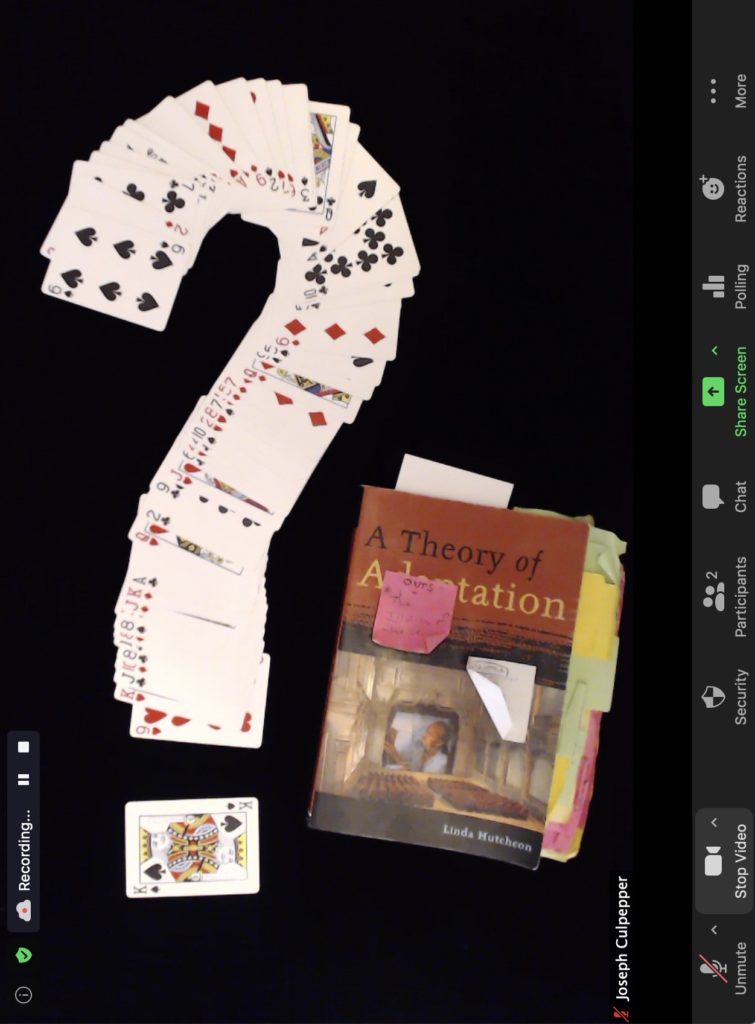
2020 is a year of rapid adaptation for everyone. Like many, Zoom is now the default mode for my teaching activities. Right now I’m teaching at Concordia University and the National Circus School of Montreal (with some workshops and consulting thrown in). The first few online sessions were a challenge. A lot of technological juggling is required to connect to students, to deliver engaging content and to combat the Zoomified flattening of the teacher-student relationship. There have been some strange moments. I remember an embarrassing squeal of feedback caused by my computer at the beginning of a lecture. It sounded like a failed sound test at a rock concert traveling through a dystopian space-time continuum. I will also never forget watching a student join a course via smartphone while driving a car (“Are you driving?!” I asked. “Yes, but it’s fine . . .” was the response. I was able to convince this student to wait until getting home before catching up with us). We’ve all learned a lot since then. In a spirit of adaptation, here are three techniques that have brought more meaning and joy to my online teaching.
Meet Every Student
The first technique is a deceptively simple one that I learned from Dr. Linda Hutcheon (author of A Theory of Adaptation and intellectual force of nature). When I was a student crammed into one of her over-enrolled graduate seminars at the University of Toronto, I remember her preparing a sign-up sheet at the end of the first class for all of us to meet with her for fifteen minutes to get to know one another. “I want to know what all of you are working on!” She said. This act, going above and beyond the typical office hours to connect with each and every one of us, was a clear sign that she appreciated each one of us despite the size of our class. She wasn’t obligated to do this, she chose to. Do such one-on-one meetings demand extra time? Yes. If you multiply 15-minutes by 48 (the number of students enrolled in my ENGL 398: Magic Languages course), the result is an extra 12 hours of labor. The returns on that investment, however, are immensely beneficial for creating a meaningful relationship between teachers and students. I would like to thank Linda for modeling this for me when I was a graduate student. I would also like to thank Vice-Provost Sandra Gabriele and her Innovation in Teaching and Learning team at Concordia University for supporting faculty members as they pour many extra hours into their teaching efforts during this pandemic to ensure high-quality instruction.
Live Group Discussions & Google Docs
Another teaching tip that is excellent for building community in the online classroom, comes from Dr. Alexandra Kovacs (University of Victoria). After a 15- to 30-minute lecture providing context for a week’s readings and theoretical concepts, I share a Google document containing a question with all students in the course and give them the ability to edit that document. Participants are then randomly put into groups of 5-6 students to respond to that question and to record observations (one or two students typically become notetakers for their group). Students meet and engage with members in their community this way. The thoughts of each smaller group are visible to all of us in that document in real time, which means that they contribute to a larger collective discussion. This document can then be referenced later for inspiration when students are thinking through essay prompts. Perhaps the most important aspect of this, however, is the mixing, meeting and engagement of students with one another in class to alleviate some of the intense isolation resulting from the “new not-quite-normal” of 2020.
Visiting Experts
The last technique I’ll share in this post is focused on diversifying intellectual dialogue and comes from Professor John Mayberry at York University. When I was brainstorming online teaching strategies with colleagues this summer, I spoke to John on the phone who suggested inviting experts to join the class from time to time for a short 15-30 minute dialogue. This plays to one of the strengths of our current life online. It is much easier and more economical right now to transport ourselves anywhere in the world. Why have students listen to long monologues that risk Zoom fatigue, when I can introduce them to some of the very creative writers and authors whose work they’re studying? So far, I’ve had experts on Shakespearean witchcraft (Dr. Jennifer McDermott), colonial conjuring (Dr. Graham Jones), and the early trick films of Georges Méliès (Dr. Matthew Solomon) exchange with the students. These conversations are so intellectually meaningful and make me feel so good that sometimes I completely forget that I’m teaching online. More than a few times, I’ve turned off the computer feeling the rush of adrenaline that comes with being part of a live online panel, delivering a lecture, or interviewing a respected colleague in a way that I know is offering my students rare insights into specialized fields.
There they are. Three tips and tricks are crucial components of my current pedagogy. It’s also important to have good hardware for teaching online, of course. But rather than write about the gear that I’ve invested in, I want to share these fundamental communication techniques for digital instruction. We are all striving to connect with each other. These strategies are helping my students to learn and to exchange ideas online. What’s working for you?